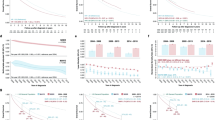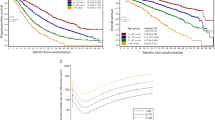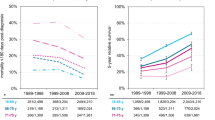Abstract
Therapy for multiple myeloma (MM) has markedly changed in the past decade with the introduction of new drugs, but it is not clear whether the improvements have been sustained. We studied 1038 patients diagnosed between 2001 and 2010, grouping patients into two 5-year periods by diagnosis, 2001–2005 and 2006–2010. The median estimated follow-up for the cohort was 5.9 years with 47% alive at the last follow-up. The median overall survival (OS) for the entire cohort was 5.2 years: 4.6 years for patients in the 2001–2005 group compared with 6.1 years for the 2006–2010 cohort (P=0.002). The improvement was primarily seen among patients over 65 years, the 6-year OS improving from 31 to 56%, P<0.001. Only 10% of patients died during the first year in the latter group, compared with 16% in the earlier cohort (P<0.01), suggesting improvement in early mortality. The improved outcomes were linked closely to the use of one or more new agents in initial therapy. The current results confirm continued survival improvement in MM and highlight the impact of initial therapy with novel agents. Most importantly, we demonstrate that the improved survival is benefitting older patients and that early mortality in this disease has reduced considerably.
This is a preview of subscription content, access via your institution
Access options
Subscribe to this journal
Receive 12 print issues and online access
$259.00 per year
only $21.58 per issue
Buy this article
- Purchase on Springer Link
- Instant access to full article PDF
Prices may be subject to local taxes which are calculated during checkout



Similar content being viewed by others
References
Mikhael JR, Dingli D, Roy V, Reeder CB, Buadi FK, Hayman SR et al. Management of newly diagnosed symptomatic multiple myeloma: updated Mayo Stratification of Myeloma and Risk-Adapted Therapy (mSMART) consensus guidelines 2013. Mayo Clin Proc 2013; 88: 360–376.
Anderson KC . The 39th David A. Karnofsky Lecture: bench-to-bedside translation of targeted therapies in multiple myeloma. J Clin Oncol 2012; 30: 445–452.
Kyle RA . Targeted therapy of multiple myeloma. Hematology 2012; 17 (Suppl 1): S125–S128.
Kumar SK, Rajkumar SV, Dispenzieri A, Lacy MQ, Hayman SR, Buadi FK et al. Improved survival in multiple myeloma and the impact of novel therapies. Blood 2008; 111: 2516–2520.
Brenner H, Gondos A, Pulte D . Recent major improvement in long-term survival of younger patients with multiple myeloma. Blood 2008; 111: 2521–2526.
Avet-Loiseau H, Durie BG, Cavo M, Attal M, Gutierrez N, Haessler J et al. Combining fluorescent in situ hybridization data with ISS staging improves risk assessment in myeloma: an International Myeloma Working Group collaborative project. Leukemia 2013; 27: 711–717.
Kumar S, Fonseca R, Ketterling RP, Dispenzieri A, Lacy MQ, Gertz MA et al. Trisomies in multiple myeloma: impact on survival in patients with high-risk cytogenetics. Blood 2012; 119: 2100–2105.
Kuiper R, Broyl A, de Knegt Y, van Vliet MH, van Beers EH, van der Holt B et al. A gene expression signature for high-risk multiple myeloma. Leukemia 2012; 26: 2406–2413.
Zhan F, Barlogie B, Mulligan G, Shaughnessy JD Jr, Bryant B . High-risk myeloma: a gene expression-based risk-stratification model for newly diagnosed multiple myeloma treated with high-dose therapy is predictive of outcome in relapsed disease treated with single-agent bortezomib or high-dose dexamethasone. Blood 2008; 111: 968–969.
Decaux O, Lode L, Magrangeas F, Charbonnel C, Gouraud W, Jezequel P et al. Prediction of survival in multiple myeloma based on gene expression profiles reveals cell cycle and chromosomal instability signatures in high-risk patients and hyperdiploid signatures in low-risk patients: a study of the Intergroupe Francophone du Myelome. J Clin Oncol 2008; 26: 4798–4805.
Richardson PG, Barlogie B, Berenson J, Singhal S, Jagannath S, Irwin D et al. A phase 2 study of bortezomib in relapsed, refractory myeloma. N Engl J Med 2003; 348: 2609–2617.
Richardson PG, Sonneveld P, Schuster MW, Irwin D, Stadtmauer EA, Facon T et al. Bortezomib or high-dose dexamethasone for relapsed multiple myeloma. N Engl J Med 2005; 352: 2487–2498.
Weber DM, Chen C, Niesvizky R, Wang M, Belch A, Stadtmauer EA et al. Lenalidomide plus dexamethasone for relapsed multiple myeloma in North America. N Engl J Med 2007; 357: 2133–2142.
Dimopoulos M, Spencer A, Attal M, Prince HM, Harousseau JL, Dmoszynska A et al. Lenalidomide plus dexamethasone for relapsed or refractory multiple myeloma. N Engl J Med 2007; 357: 2123–2132.
Rajkumar SV, Blood E, Vesole D, Fonseca R, Greipp PR . Phase III clinical trial of thalidomide plus dexamethasone compared with dexamethasone alone in newly diagnosed multiple myeloma: a clinical trial coordinated by the Eastern Cooperative Oncology Group. J Clin Oncol 2006; 24: 431–436.
Weber D, Rankin K, Gavino M, Delasalle K, Alexanian R . Thalidomide alone or with dexamethasone for previously untreated multiple myeloma. J Clin Oncol 2003; 21: 16–19.
Siegel DS, Martin T, Wang M, Vij R, Jakubowiak AJ, Lonial S et al. A phase 2 study of single-agent carfilzomib (PX-171-003-A1) in patients with relapsed and refractory multiple myeloma. Blood 2012; 120: 2817–2825.
Miguel JS, Weisel K, Moreau P, Lacy M, Song K, Delforge M et al. Pomalidomide plus low-dose dexamethasone versus high-dose dexamethasone alone for patients with relapsed and refractory multiple myeloma (MM-003): a randomised, open-label, phase 3 trial. Lancet Oncol 2013; 14: 1055–1066.
Fonseca R, Blood E, Rue M, Harrington D, Oken MM, Kyle RA et al. Clinical and biologic implications of recurrent genomic aberrations in myeloma. Blood 2003; 101: 4569–4575.
Greipp PR, Kumar S . Plasma cell labeling index. Methods Mol Med 2005; 113: 25–35.
Kaplan E, Meier P . Nonparametric estimation from incomplete observations. J Am Stat Assoc 1958; 53: 457–481.
Avet-Loiseau H, Attal M, Moreau P, Charbonnel C, Garban F, Hulin C et al. Genetic abnormalities and survival in multiple myeloma: the experience of the Intergroupe Francophone du Myelome. Blood 2007; 109: 3489–3495.
Jagannath S, Richardson PG, Sonneveld P, Schuster MW, Irwin D, Stadtmauer EA et al. Bortezomib appears to overcome the poor prognosis conferred by chromosome 13 deletion in phase 2 and 3 trials. Leukemia 2007; 21: 151–157.
Neben K, Lokhorst HM, Jauch A, Bertsch U, Hielscher T, van der Holt B et al. Administration of bortezomib before and after autologous stem cell transplantation improves outcome in multiple myeloma patients with deletion 17p. Blood 2012; 119: 940–948.
Wijermans P, Schaafsma M, Termorshuizen F, Ammerlaan R, Wittebol S, Sinnige H et al. Phase III study of the value of thalidomide added to melphalan plus prednisone in elderly patients with newly diagnosed multiple myeloma: the HOVON 49 Study. J Clin Oncol 2010; 28: 3160–3166.
Hulin C, Facon T, Rodon P, Pegourie B, Benboubker L, Doyen C et al. Efficacy of melphalan and prednisone plus thalidomide in patients older than 75 years with newly diagnosed multiple myeloma: IFM 01/01 trial. J Clin Oncol 2009; 27: 3664–3670.
Facon T, Mary JY, Hulin C, Benboubker L, Attal M, Pegourie B et al. Melphalan and prednisone plus thalidomide versus melphalan and prednisone alone or reduced-intensity autologous stem cell transplantation in elderly patients with multiple myeloma (IFM 99-06): a randomised trial. Lancet 2007; 370: 1209–1218.
Palumbo A, Bringhen S, Caravita T, Merla E, Capparella V, Callea V et al. Oral melphalan and prednisone chemotherapy plus thalidomide compared with melphalan and prednisone alone in elderly patients with multiple myeloma: randomised controlled trial. Lancet 2006; 367: 825–831.
San Miguel JF, Schlag R, Khuageva NK, Dimopoulos MA, Shpilberg O, Kropff M et al. Bortezomib plus melphalan and prednisone for initial treatment of multiple myeloma. N Engl J Med 2008; 359: 906–917.
Kumar SK, Lacy MQ, Dispenzieri A, Buadi FK, Hayman SR, Dingli D et al. Early versus delayed autologous transplantation after immunomodulatory agents-based induction therapy in patients with newly diagnosed multiple myeloma. Cancer 2012; 118: 1585–1592.
Kumar SK, Dingli D, Lacy MQ, Dispenzieri A, Hayman SR, Buadi FK et al. Autologous stem cell transplantation in patients of 70 years and older with multiple myeloma: results from a matched pair analysis. Am J Hematol 2008; 83: 614–617.
Sirohi B, Powles R, Treleaven J, Mainwaring P, Kulkarni S, Pandha H et al. The role of autologous transplantation in patients with multiple myeloma aged 65 years and over. Bone Marrow Transplant 2000; 25: 533–539.
Augustson BM, Begum G, Dunn JA, Barth NJ, Davies F, Morgan G et al. Early mortality after diagnosis of multiple myeloma: analysis of patients entered onto the United kingdom Medical Research Council trials between 1980 and 2002-Medical Research Council Adult Leukaemia Working Party. J Clin Oncol 2005; 23: 9219–9226.
Moreau P, Planche L, Attal M, Hulin C, Facon T, Caillot D et al. The combination of ISS 3, high LDH and t(4;14) and/or Del(17p) identify a simple prognostic index for overall survival in patients treated with novel agents-based induction therapy and front-line autologous stem cell transplantation, and allow the definition of a subgroup of patients at high-risk of early death from progressive disease. ASH Ann Meeting Abstr 2012; 120: 598.
Greipp PR, San Miguel J, Durie BG, Crowley JJ, Barlogie B, Blade J et al. International staging system for multiple myeloma. J Clin Oncol 2005; 23: 3412–3420.
Dimopoulos MA, Barlogie B, Smith TL, Alexanian R . High serum lactate dehydrogenase level as a marker for drug resistance and short survival in multiple myeloma. Ann Intern Med 1991; 115: 931–935.
Terpos E, Katodritou E, Roussou M, Pouli A, Michalis E, Delimpasi S et al. High serum lactate dehydrogenase adds prognostic value to the international myeloma staging system even in the era of novel agents. Eur J Haematol 2010; 85: 114–119.
Greipp PR, Lust JA, O'Fallon WM, Katzmann JA, Witzig TE, Kyle RA . Plasma cell labeling index and beta 2-microglobulin predict survival independent of thymidine kinase and C-reactive protein in multiple myeloma. Blood 1993; 81: 3382–3387.
Kapoor P, Kumar S, Mandrekar SJ, Laumann KM, Dispenzieri A, Lacy MQ et al. Efficacy of thalidomide- or lenalidomide-based therapy in proliferative multiple myeloma. Leukemia 2011; 25: 1195–1197.
Hose D, Reme T, Hielscher T, Moreaux J, Messner T, Seckinger A et al. Proliferation is a central independent prognostic factor and target for personalized and risk-adapted treatment in multiple myeloma. Haematologica 2011; 96: 87–95.
Acknowledgements
This work was supported in part by the Mayo Clinic Hematological Malignancies Program and Paul Calabresi K12 Award (Grant No. CA90628), by Grants CA168762, CA07476, CA62242, CA100707 and CA83724 from the National Cancer Institute, and by the Jabbs Foundation and the Henry J. Predolin Foundation.
Author contributions
SKK was involved in design of concept, data collection, analysis and writing the paper. AD, MQL, SRH, SRZ, FKB, NL, RAK, SVR, SP, PK, DD, SJR, JL, AM and MAG were involved in writing the manuscript.
Author information
Authors and Affiliations
Corresponding author
Ethics declarations
Competing interests
The authors declare no conflict of interest.
Additional information
Supplementary Information accompanies this paper on the Leukemia website
Supplementary information
Rights and permissions
About this article
Cite this article
Kumar, S., Dispenzieri, A., Lacy, M. et al. Continued improvement in survival in multiple myeloma: changes in early mortality and outcomes in older patients. Leukemia 28, 1122–1128 (2014). https://doi.org/10.1038/leu.2013.313
Received:
Accepted:
Published:
Issue Date:
DOI: https://doi.org/10.1038/leu.2013.313
Keywords
This article is cited by
-
Fc receptor-like 5 (FCRL5)-directed CAR-T cells exhibit antitumor activity against multiple myeloma
Signal Transduction and Targeted Therapy (2024)
-
Excellent long-term pain response and local control following postoperative radiotherapy in patients with multiple myeloma
Strahlentherapie und Onkologie (2024)
-
Primary analysis of a prospective cohort study of Japanese patients with plasma cell neoplasms in the novel drug era (2016–2021)
International Journal of Hematology (2024)
-
Large-scale real-life analysis of survival and usage of therapies in multiple myeloma
Journal of Hematology & Oncology (2023)
-
Trends in utilization of stored cryopreserved autologous peripheral hematopoietic cells intended for a second (or beyond) autologous hematopoietic cell transplantation in patients with multiple myeloma: a single center experience
Bone Marrow Transplantation (2023)



